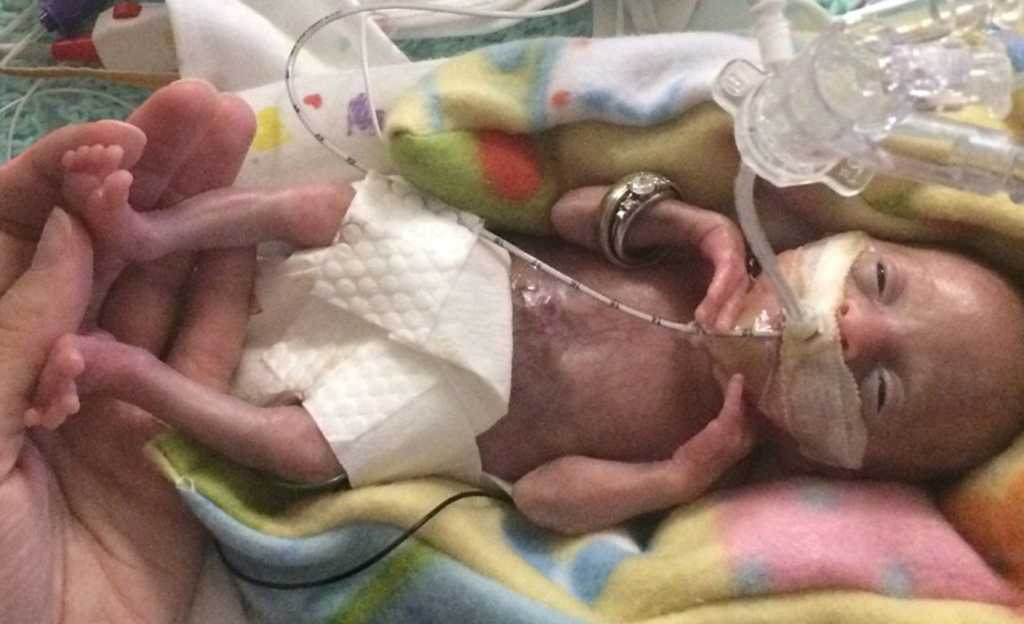In 2014, Courtney Stensrud went into labor and prematurely gave birth to her daughter just under 22 weeks into her pregnancy at Methodist Children’s Hospital. While waiting in the antepartum room in San Antonio, Texas, she found herself on the internet searching for other mothers who had been through childbirth this early into their pregnancy.
“There were stories of 22-weekers, 23-weekers, but nothing about 21-weekers. So I knew that there was little to no survival or viability at 21 weeks,” Courtney said.
Stensrud gave birth to her daughter at only 21 weeks and four days gestation. To compare, most mothers give birth at 39 to 40 weeks, where the baby is healthiest to leave the womb. Stensrud experienced a premature rupture of membranes which caused her to go into labor so early. She was also diagnosed with an infection of her placental membrane called chorioamnionitis.
‘It…Rejects Scientific Fact’: Trump Excoriates Senate’s Failure to Ban Abortion After 20 Weeks
Courtney Stensrud and her husband call their fun-loving, spunky daughter their miracle baby.
“If you didn’t know that she was so preemie, you would think she’s a normal 3-year-old,” Stensrud said. “In her school, she is keeping up with all the other 3-year-olds. She loves playing with other kids. She loves everything I think a normal 3-year-old likes. She loves her baby dolls, she loves books, and she loves make-believe. She loves anything and everything her (older) brother is doing.”
According to the journal Pediatrics, “she may be the most premature known survivor to date.”
When Stensrud gave birth, she was informed that her daughter had an extremely low chance of survival and told they should not try to resuscitate the baby. Dr. Kaashif Ahmad, a MEDNAX-affiliated neonatologist at the hospital and lead author of the case report told the parents as Stensrud held her 15-ounce daughter in her arms.
The doctor’s response was protocol, as most pediatrics and obstetrics societies agree that 22 weeks of gestation is the lower threshold of viability.
“Although I was listening to him, I just felt something inside of me say, ‘Just have hope and have faith.’ It didn’t matter to me that she was 21 weeks and four days. I didn’t care,” Stensrud said.
Stensrud had faith that her daughter would survive.
“As he was talking to me, I just said, ‘Will you try?’ And he said he would, and three years later, we have our little miracle baby,” Stensrud said.
“But when the mother asked that we do everything for her daughter, despite having no reason to believe the baby would survive, I just made the decision to proceed with a vigorous resuscitation,” Ahmad said.
“So we placed her under an overhead warmer, we listened, and we heard her heart rate, which we were not necessarily expecting,” he said. “We immediately placed a breathing tube in her airway. We started giving her oxygen, and really pretty quickly, her heart rate began to rise. She very slowly changed colors from blue to pink, and she actually began to move and began to start breathing within a few minutes.”
Stensrud hopes that other women who are delivering early can find her story online and see that there is hope for her premature baby. People need to know its possible, as Stensrud was happy she learned.
“I don’t tell her story a lot, but when I do, people are amazed,” she said. “If there’s another woman in antepartum that is searching Google, they can find this story and they can find a little bit of hope and a little bit of faith.”
The World Health Organization estimated that 15 million babies are born before 37 weeks gestation each year. Furthermore, one out of every 10 babies born in the United States last year was born before 37 weeks gestation last year.
The number of preterm births has been on a rise in the United States over the past years. From 2015 to 2016 an addition 8,000 babies were born preterm in the United States.
However, thanks to advances in medicine, the survival rate of these premature babies is increasing. Survival rates for babies born from 22 to 24 weeks’ gestation in the United States rose from 30% to 36% from 2000 to 2011.
Despite these advances, babies born at 22-weeks-old can still be legally aborted in some parts of the U.S. While most states ban abortion between 22-weeks and viability, some states have loosened restrictions on abortion. Alaska, Colorado, New Hampshire, New Jersey, New Mexico, Oregon and Vermont do not limit abortion by the baby’s gestational age, and three states allow women to have abortions up to 28-weeks.



